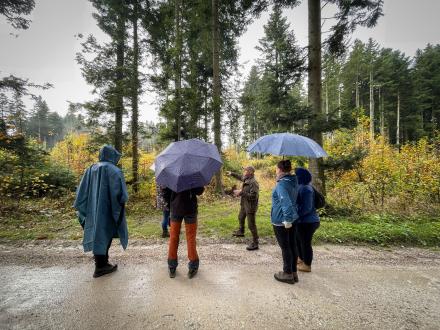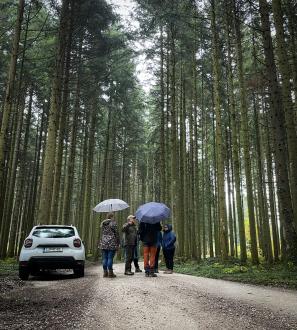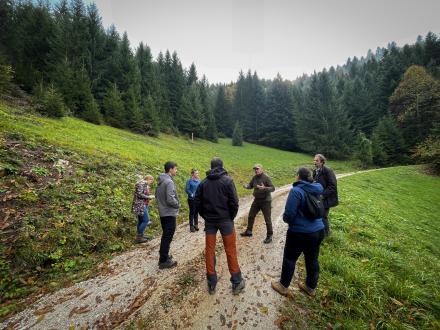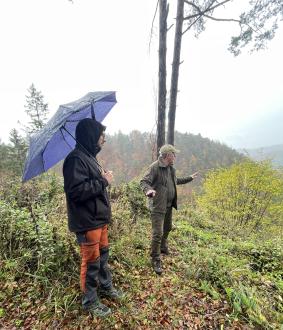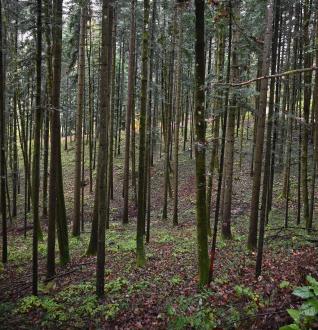One of the country’s most densely forested areas with a long tradition of forestry, lasting for centuries, is the Kočevje region, where forester Črtomir Vilhar has managed a 1,000-hectare forest estate near Velike Lašče for more than three decades.
‘’Welcome! First, some coffee and dessert, and introduction on Slovenian forestry by expert colleagues here, and then we’ll head to the forest,’’ said Vilhar, greeting us at his home. Wherever you turn, you can see the vivid nature surrounding the property which has been in the possession of his family for generations.
The Kosler forest is part of the Group Forest Management (FM) certificate administered by Slovenian State Forests (SiDG). Before the field visit, Eva Cerjak, representing SiDG, provided an insightful overview of the development and evolution of forestry in Slovenia.
Slovenia is a small country but very diverse, with many mountains. The Alps are with carbonate bedrock, and the highest peak reaching 2,864 m. On the other side, Slovenia touches the Pannonian lowland, and a significant part of the country is with Dinaric landscape, together with the coastal north which has a Mediterranean type of climate. ,,In between, there are hilly landscapes, valleys, and basins. Because of these very different natural conditions, there is also a great diversity of natural vegetation and, as we say in forestry, a wide variety of forest site types”, Eva tells us.
The first forest management planning started in the forests of Trnovo above Gorica in 1771. It used the advanced German method for wood stock calculations – the same method used in Germany since 1752. Eva says that the well-known forester Jožef Koller in 1842 already used natural regeneration with shelter cutting. After 1948, forestry in Slovenia shifted strongly toward close-to-nature and sustainable management. The main goal was to restore degraded forests to their full natural capacity in a close-to-nature and sustainable way — with great success.
,,In the 1970s, a lot of forest infrastructure was built (for example, in Kočevje alone, 500–600 km of tractor trails and 50 km of forest roads per year). Wood industry development went hand-in-hand with forestry — sawmills were located close to forests and specialized in local species. Unfortunately, most of this industry collapsed after Slovenia’s independence.
By the 1970s and 1980s, multifunctional forest management became law and practice — including public consultations and stakeholder participation. Foresters also began selecting forest reserves (around 9,500 ha) that were excluded from management. Forest inventories moved from full inventories to sampling methods, which are still used today, including permanent plots for long-term data collection”, Eva adds.
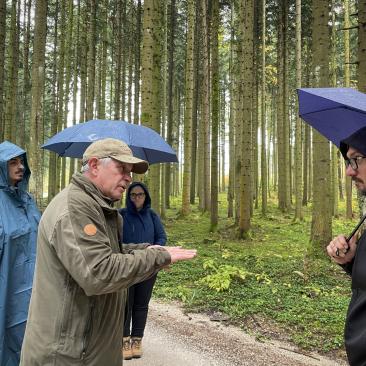
As Črtomir Vilhar explained, the forest property is managed by Kosler Family since 1850 with regular 10 years forest management plans since 1902. It was once dominated by spruce monocultures due to intensive logging and replanting, but the forest is now managed through sustainable, biodiversity-focused practices, which has resulted in a healthy mix of native tree species suited to the area.
Vilhar proudly showed the FSC’s team the hectares of forests he manages filled with healthy trees, fresh air and nature preserved for generations to come.
The purpose has been to move from 99% coniferous composition to a more mix composition with increasing presence of broadleaves species and implementation of “Freestyle” sylviculture approaches, to cope with natural regeneration of forests but also to face natural disturbances (windstorm, ice breaks and pest outbreaks) and climate change (change of species habitat due to global warming) .
Most recent interventions are made with support to natural regeneration after disturbances (artificial plantations sites), multifunctional use of the forest (hunting area, recreational uses, etc.), conservation of monumental trees and tending sylviculture intervention with freestyle approaches. The vast areas of carefully planned tree mixing, tell the story of a tradition of responsible forestry that exists in this part of Slovenia, for a long period of time. Total volume has passed from 180 cm/ha in 1902 to 360 cm/ha nowadays.
Since 2010 the management of this rich forest and – consequently – the timber placed on the market are FSC certified within the certification group of private forest owners managed by SiDG. The get the FSC certification is the best way to validate, through an annual independent audit, the positive socio-economic and environmental impact of such virtuous tradition or responsible forest management by Kosler family.
